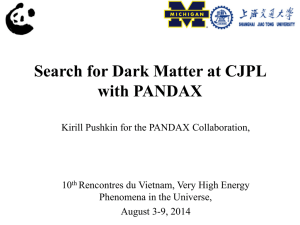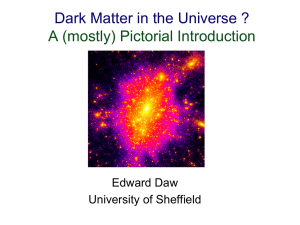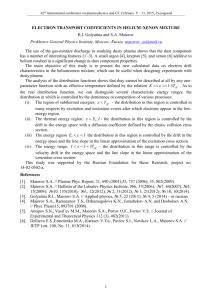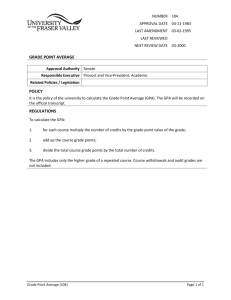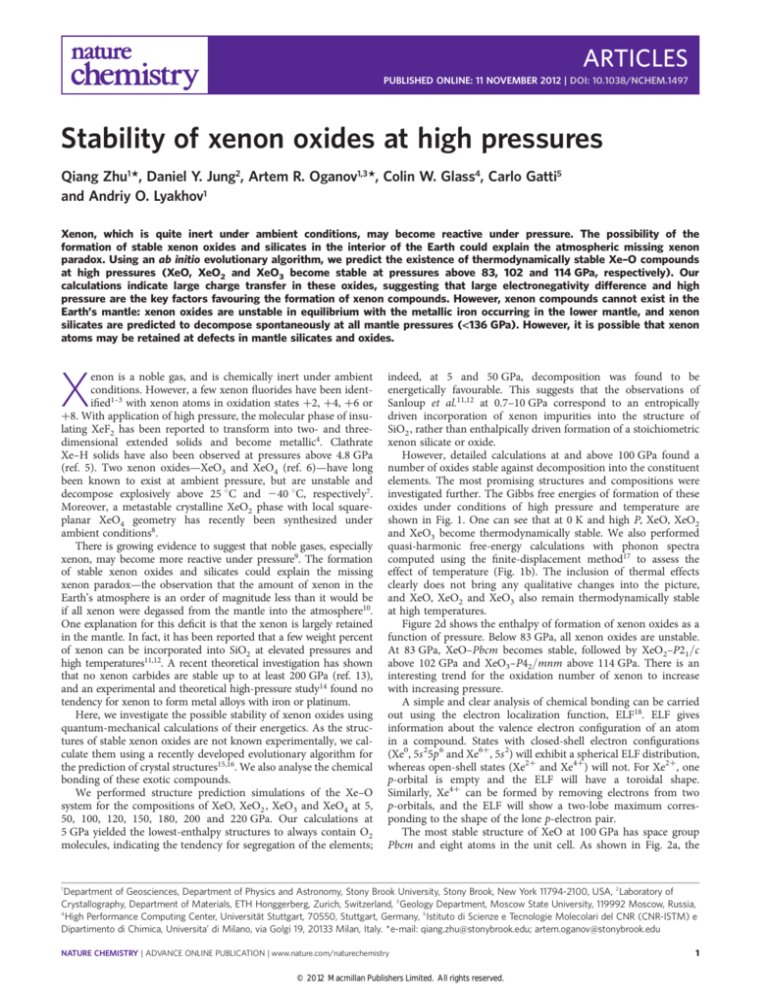
ARTICLES
PUBLISHED ONLINE: 11 NOVEMBER 2012 | DOI: 10.1038/NCHEM.1497
Stability of xenon oxides at high pressures
Qiang Zhu1 *, Daniel Y. Jung2, Artem R. Oganov1,3 *, Colin W. Glass4, Carlo Gatti5
and Andriy O. Lyakhov1
Xenon, which is quite inert under ambient conditions, may become reactive under pressure. The possibility of the
formation of stable xenon oxides and silicates in the interior of the Earth could explain the atmospheric missing xenon
paradox. Using an ab initio evolutionary algorithm, we predict the existence of thermodynamically stable Xe–O compounds
at high pressures (XeO, XeO2 and XeO3 become stable at pressures above 83, 102 and 114 GPa, respectively). Our
calculations indicate large charge transfer in these oxides, suggesting that large electronegativity difference and high
pressure are the key factors favouring the formation of xenon compounds. However, xenon compounds cannot exist in the
Earth’s mantle: xenon oxides are unstable in equilibrium with the metallic iron occurring in the lower mantle, and xenon
silicates are predicted to decompose spontaneously at all mantle pressures (<136 GPa). However, it is possible that xenon
atoms may be retained at defects in mantle silicates and oxides.
X
enon is a noble gas, and is chemically inert under ambient
conditions. However, a few xenon fluorides have been identified1–3 with xenon atoms in oxidation states þ2, þ4, þ6 or
þ8. With application of high pressure, the molecular phase of insulating XeF2 has been reported to transform into two- and threedimensional extended solids and become metallic4. Clathrate
Xe–H solids have also been observed at pressures above 4.8 GPa
(ref. 5). Two xenon oxides—XeO3 and XeO4 (ref. 6)—have long
been known to exist at ambient pressure, but are unstable and
decompose explosively above 25 8C and 240 8C, respectively7.
Moreover, a metastable crystalline XeO2 phase with local squareplanar XeO4 geometry has recently been synthesized under
ambient conditions8.
There is growing evidence to suggest that noble gases, especially
xenon, may become more reactive under pressure9. The formation
of stable xenon oxides and silicates could explain the missing
xenon paradox—the observation that the amount of xenon in the
Earth’s atmosphere is an order of magnitude less than it would be
if all xenon were degassed from the mantle into the atmosphere10.
One explanation for this deficit is that the xenon is largely retained
in the mantle. In fact, it has been reported that a few weight percent
of xenon can be incorporated into SiO2 at elevated pressures and
high temperatures11,12. A recent theoretical investigation has shown
that no xenon carbides are stable up to at least 200 GPa (ref. 13),
and an experimental and theoretical high-pressure study14 found no
tendency for xenon to form metal alloys with iron or platinum.
Here, we investigate the possible stability of xenon oxides using
quantum-mechanical calculations of their energetics. As the structures of stable xenon oxides are not known experimentally, we calculate them using a recently developed evolutionary algorithm for
the prediction of crystal structures15,16. We also analyse the chemical
bonding of these exotic compounds.
We performed structure prediction simulations of the Xe–O
system for the compositions of XeO, XeO2 , XeO3 and XeO4 at 5,
50, 100, 120, 150, 180, 200 and 220 GPa. Our calculations at
5 GPa yielded the lowest-enthalpy structures to always contain O2
molecules, indicating the tendency for segregation of the elements;
indeed, at 5 and 50 GPa, decomposition was found to be
energetically favourable. This suggests that the observations of
Sanloup et al.11,12 at 0.7–10 GPa correspond to an entropically
driven incorporation of xenon impurities into the structure of
SiO2 , rather than enthalpically driven formation of a stoichiometric
xenon silicate or oxide.
However, detailed calculations at and above 100 GPa found a
number of oxides stable against decomposition into the constituent
elements. The most promising structures and compositions were
investigated further. The Gibbs free energies of formation of these
oxides under conditions of high pressure and temperature are
shown in Fig. 1. One can see that at 0 K and high P, XeO, XeO2
and XeO3 become thermodynamically stable. We also performed
quasi-harmonic free-energy calculations with phonon spectra
computed using the finite-displacement method17 to assess the
effect of temperature (Fig. 1b). The inclusion of thermal effects
clearly does not bring any qualitative changes into the picture,
and XeO, XeO2 and XeO3 also remain thermodynamically stable
at high temperatures.
Figure 2d shows the enthalpy of formation of xenon oxides as a
function of pressure. Below 83 GPa, all xenon oxides are unstable.
At 83 GPa, XeO–Pbcm becomes stable, followed by XeO2–P21/c
above 102 GPa and XeO3–P42/mnm above 114 GPa. There is an
interesting trend for the oxidation number of xenon to increase
with increasing pressure.
A simple and clear analysis of chemical bonding can be carried
out using the electron localization function, ELF18. ELF gives
information about the valence electron configuration of an atom
in a compound. States with closed-shell electron configurations
(Xe0, 5s 25p 6 and Xe6þ, 5s 2) will exhibit a spherical ELF distribution,
whereas open-shell states (Xe2þ and Xe4þ) will not. For Xe2þ, one
p-orbital is empty and the ELF will have a toroidal shape.
Similarly, Xe4þ can be formed by removing electrons from two
p-orbitals, and the ELF will show a two-lobe maximum corresponding to the shape of the lone p-electron pair.
The most stable structure of XeO at 100 GPa has space group
Pbcm and eight atoms in the unit cell. As shown in Fig. 2a, the
1
Department of Geosciences, Department of Physics and Astronomy, Stony Brook University, Stony Brook, New York 11794-2100, USA, 2 Laboratory of
Crystallography, Department of Materials, ETH Honggerberg, Zurich, Switzerland, 3 Geology Department, Moscow State University, 119992 Moscow, Russia,
4
High Performance Computing Center, Universität Stuttgart, 70550, Stuttgart, Germany, 5 Istituto di Scienze e Tecnologie Molecolari del CNR (CNR-ISTM) e
Dipartimento di Chimica, Universita’ di Milano, via Golgi 19, 20133 Milan, Italy. * e-mail: qiang.zhu@stonybrook.edu; artem.oganov@stonybrook.edu
NATURE CHEMISTRY | ADVANCE ONLINE PUBLICATION | www.nature.com/naturechemistry
© 2012 Macmillan Publishers Limited. All rights reserved.
1
ARTICLES
a
0.4
NATURE CHEMISTRY
b
T=0K
DOI: 10.1038/NCHEM.1497
P = 120 GPa
0.0
P = 50 GPa
0.2
0.0
ΔG (eV per atom)
Hformation (eV per atom)
–0.1
P = 100 GPa
P = 120 GPa
–0.2
P = 150 GPa
–0.4
P = 200 GPa
T=0K
–0.2
T = 1,000 K
–0.3
–0.4
T = 2,000 K
–0.5
T = 3,000 K
–0.6
–0.6
0.0
0.2
0.4
0.6
X [NO/(NXe + NO)]
0.8
1.0
0.0
0.2
0.4
0.6
X [NO/(NXe + NO)]
0.8
1.0
Figure 1 | Thermal stability of Xe–O compounds. a, Predicted formation enthalpy of Xe–O compounds at high P and T ¼ 0 K. b, Predicted Gibbs free energy
of formation of Xe–O compounds at different temperatures and P ¼ 120 GPa. The compounds shown are (left to right) Xe, XeO, XeO2 , XeO3 and O. For
oxygen, the structures of the z-phase36 and 1-phase37 were used. For xenon, the face-centred cubic (fcc)38 and hexagonal close-packed (hcp)39 structures
were considered, and hcp was found energetically more favourable above 100 GPa, in agreement with experiments40. For clarity, the Gibbs free energies of
formation in b were shifted by 20.1, 20.2 and 20.3 eV/atom at 1,000, 2,000 and 3,000 K, respectively.
xenon atoms are in a twofold (linear) coordination and the Xe–O
bonds form chains, with O–Xe–O angles of 175.68 and Xe–O–Xe
angles of 112.68. The alternating Xe–O bond lengths are 2.0 and
2.1 Å. The ELF picture (Fig. 2a) shows a toroidal maximum of
ELF around each xenon atom, exactly what one should expect for
the Xe2þ state. Above 145 GPa, XeO undergoes a phase transformation and forms a structure with the space group P21/m. In this
structure there are two different environments for the Xe atoms
(Xe1 and Xe2); Xe1 atoms connect to four oxygen atoms and
have a square coordination, forming the same chains as in XeO2
(suggesting that Xe1 atoms are in the tetravalent Xe4þ state).
However, Xe2 can be described as neutral and not bonded to
other atoms by any significant bonds. The presence of neutral
non-bonded atoms in this structure is energetically favourable as
it increases the packing density.
In XeO2 , the stable structure above 102 GPa has space group
P21/c and 24 atoms in the unit cell. The xenon atoms have a
slightly non-planar square coordination and the structure consists
of one-dimensional ribbons of edge-sharing XeO4 squares (Xe–O
distances of 2.0 and 2.1 Å), with four Xe–O bonds and two
lone-pair ELF maxima forming an octahedron, as in the
ambient-pressure metastable phase8. Just as in XeO, there are no
peaks visible in the ELF isosurface along the Xe–O bonds
(Fig. 2b). Above 198 GPa XeO2–P21/c transforms into the
XeO2–Cmcm structure. This non-trivial structure can be represented as having parallel zigzag xenon chains (Xe–Xe distances
of 2.62 Å), with each xenon atom having two neighbouring
oxygen atoms in the form of bent XeO2 molecules (Xe–O distance
of 1.95 Å; O–Xe–O angle of 160.7 Å).
XeO3 becomes stable at 114 GPa. Its structure has space group
P42/mnm and 16 atoms in the unit cell. It is stable against
decomposition into Xe and O2 , as well as into XeO or XeO2
and O2. As shown in the Supplementary Fig. S3a,b, the
P42/mnm–XeO3 structure is composed of two sublattices: square
XeO2 chains, suggesting the Xe4þ states, and linear chains made
of O2 dumbbells. Above 145 GPa, a new phase is formed where
the molecules in the linear –O2–O2– chains are partly dissociated
and we observe the –O2–O– chain in the C2/c phase with 48
atoms per unit cell (Supplementary Fig. S3c). Above 198 GPa, the
structure transforms into a Pmmn phase with eight atoms
2
per unit cell. In this remarkable structure, oxygen atoms form
anticuboctahedra around the xenon atoms (Fig. 2c). The ELF distribution around xenon atoms in the Pmmn phase is spherical, which
points to the Xe6þ valence state with a spherically symmetric 5s 2
valence shell. Clearly, detailed analysis of the ELF distribution confirms the tendency to increasing oxidation states under pressure.
Xenon fluorides are stable under ambient conditions, xenon
oxides become stable above 83 GPa, and xenon carbides are unstable
at the very least up to 200 GPa (ref. 13). It thus appears that xenon
forms compounds most readily with the most electronegative atoms,
which in turn suggests that ionicity is essential. This is somewhat
counterintuitive, given that the xenon atom has a very stable
closed valence shell and its ionization potential and electronegativity
are rather high. The electronegativity difference (1.4 for Xe–F, 0.8
for Xe–O and 0.56 for Xe–C) determines the degree of ionicity
under ambient conditions. However, ionicity can be enhanced
under pressure. Indeed, spontaneous ionization under pressure
was recently found even in an element—boron19.
To obtain further chemical insight into these exotic xenon
oxides, we selected some of the stable structures containing Xe2þ,
Xe4þ and Xe6þ, namely, XeO–Pbcm at 100 GPa, XeO2–P21/c at
150 GPa, and XeO3–Pmmn at 200 GPa. Figure 3 shows the densities
of states and their projection onto atomic orbitals for these structures. All of these xenon oxides are narrow-gap semiconductors.
Using state-of-the-art GW calculations, we obtained the bandgaps:
1.52 eV for XeO–Pbcm at 100 GPa, 0.52 eV for XeO2–P21/c at
150 GPa, 0.15 eV for XeO3–Pmmn at 200 GPa (these values should
be accurate to within 5–10%).
The highest valence band levels are dominated by the p-orbitals
of oxygen and xenon. Both the atom-projected densities of states
and energy-decomposed electron densities suggest charge
transfer from xenon to oxygen atoms. The contribution of the
xenon p-orbitals decreases with increasing xenon oxidation
number. The valence states dominated by p contributions in
XeO–Pbcm contain about 40 electrons, with almost equal contributions from oxygen and xenon, namely 4.51 p electrons per
xenon atom and 4.93 p electrons per oxygen atom. In the case of
XeO2–P21/c, there are about 112 such electrons, 31.94 from
xenon and 80.16 from oxygen, or 3.99 p electrons per xenon and
5.01 p electrons per oxygen. This means that each xenon atom loses
NATURE CHEMISTRY | ADVANCE ONLINE PUBLICATION | www.nature.com/naturechemistry
© 2012 Macmillan Publishers Limited. All rights reserved.
NATURE CHEMISTRY
ARTICLES
DOI: 10.1038/NCHEM.1497
c
a
b
d
1.0
XeO-Pbcm
XeO-P21/m
0.5
XeO3-P42/mnm
0.0
XeO3-C2/c
–2.5
XeO-Pbcm
–2.0
60
80
100
120
XeO-P21/m
XeO2-P21/c & XeO3-C2/c
XeO-Pbcm & XeO2-P21/c
–1.0
–1.5
XeO-Pbcm
XeO2-P21/c & XeO3-P42/mnm
–0.5
No xenon oxides
ΔH (eV per formula unit)
XeO2-P21/c
140
160
180
200
Pressure (GPa)
Figure 2 | Crystal structures, chemical bonding and stability range of Xe–O compounds. a, Crystal structure of XeO (Pbcm) at 100 GPa, and its ELF
distribution (ELF ¼ 0.85 isosurface) in the Xe–O chain. b, Crystal structure of XeO2 (P21/c) at 120 GPa, and its ELF distribution (ELF ¼ 0.85) in the chains of
XeO4 squares. c, Crystal structure of XeO3 (Pmmn) at 200 GPa, and its ELF distribution (ELF ¼ 0.82) in XeO12 anticuboctahedra. d, Enthalpies of formation
of all stable xenon oxides are shown by lines. Stability fields are delineated by colours (at 198 GPa, P21/c XeO2 transforms to a Cmcm structure, and
C2/c-XeO3 transforms to the Pmmn phase, that is, just at the edge of the graph).
EF
EF
b
XeO
Density of states (a.u.)
Density of states (a.u.)
Op
Os
Xe d
Xe p
Od
Op
Os
Xe d
Xe p
Op
Os
Xe d
Xe p
Xe s
Xe s
Xe s
–10
XeO3
Od
Od
–20
EF
c
XeO2
Density of states (a.u.)
a
0
Energy (eV)
10
–20
–10
0
10
Energy (eV)
–20
–10
0
10
Energy (eV)
Figure 3 | Electronic structures of selected Xe–O compounds. a–c, Total and projected densities of states for XeO–Pbcm at 100 GPa (a), XeO2–P21/c at
150 GPa (b), XeO3–Pmmn at 200 GPa (c). The sum over the plotted projections gives the total density of states for each system. The Fermi energy (EF) is
set as the highest valence band energy.
two p electrons, which are transferred into a p orbital of the oxygen
atoms (each oxygen atom takes one p electron). Finally, in XeO3–
Pmmn there are about 36 electrons in the valence states dominated
by p orbital contributions, 5.48 electrons from xenon and 30.10
from oxygen, leading to a further lowering to 2.74 electrons on
xenon p orbitals and again to 5 electrons on oxygen p orbitals.
Charge transfer was also investigated using Bader’s analysis of
electron density20. For XeO–Pbcm the net charge on the xenon
NATURE CHEMISTRY | ADVANCE ONLINE PUBLICATION | www.nature.com/naturechemistry
© 2012 Macmillan Publishers Limited. All rights reserved.
3
ARTICLES
NATURE CHEMISTRY
Table 1 | Eigenvalues of the traceless quadrupole moment
tensor from the atomic Bader integration.
System
XeO
XeO2–Xe1
XeO2–Xe2
XeO3
m1
m2
23.49
25.50
25.90
20.38
22.04
1.83
2.33
0.21
m3
5.53
3.67
3.57
0.36
The selected xenon oxide structures are XeO–Pbcm at 100 GPa, XeO2–P21/c at 150 GPa, and XeO3–
Pmmn at 200 GPa.
atoms is 1.01, but it increases to 1.995, on average, in XeO2–P21/c
and to 2.754 in XeO3–Pmmn. Note that the net charge on the
oxygen atoms stays almost the same in all three compounds and
is very close to –1. This corresponds to an ionicity of 50%. Note
that the charge transfer described by Bader analysis of an observable
function, the electron density, confirms that found using orbitalprojected density of states, a totally independent approach.
Bader analysis yields not only the net atomic charges, but also
more subtle characteristics, such as the traceless quadrupole
moment tensor Q(V), whose three eigenvalues mi (i ¼ 1,3)
provide a good quantitative indicator of the departure of an
atomic basin from sphericity. The eigenvectors associated with the
eigenvalues mi give the principal directions for relative charge
accumulation and depletion. For a spherical distribution, eigenvalues mi are all equal to zero. A deviation from zero indicates
asphericity: negative eigenvalues mi arise from an accumulation of
charge in the direction associated with the corresponding eigenvector and at the expense of the directions associated with positive
mi. Our calculation (Table 1) shows that the xenon atoms in XeO3–
Pmmn are definitely more spherical, with eigenvalues mi all close to
zero and about one order of magnitude lower than those for XeO2
and XeO. This agrees with the ELF picture while also providing a
quantitative measure of asphericity. XeO–Pbcm (with one p
orbital partially empty) has, in agreement with the orbital picture,
one direction of relative charge depletion (associated with m3) and
two directions of unequal relative charge accumulation (associated
with m1 and m2). Finally, in XeO2–P21/c there is one direction of
relative charge accumulation (associated with m1) and two of
unequal relative charge depletion (associated with m2 and m3), in
agreement with the picture of two (partially) empty p orbitals.
High oxidation states, together with the high electronegativity
of xenon, imply strong oxidative properties for xenon oxides. How
likely is it that xenon oxides (or silicates) could exist in the Earth’s
lower mantle, thus explaining the missing xenon paradox? As discussed above, xenon oxides are only stable above 83 GPa, that is, at
pressures corresponding to the lower mantle, where metallic iron
should be present and the environment is strongly reducing21,22.
The predicted xenon oxides are very strong oxidants and our calculations show that they will be reduced by iron, producing iron
oxide and free xenon. We thus turned to the exploration of xenon silicates, focusing on XeSiO3 and Xe2SiO4 , which contain the least oxidized xenon. However, these, and all other investigated compositions,
were unstable towards decomposition into XeO, XeO2 , SiO2 and
elemental xenon. We therefore conclude that, although xenon
oxides are stable in the Xe–O system at pressures and temperatures
of the Earth’s lower mantle, in its strongly reducing environment
neither silicates nor oxides of xenon can exist. Xenon silicates are
unstable to decomposition, and xenon oxides will be reduced by metallic iron present in the lower mantle.
In summary, we have predicted the stability of xenon oxides at
high pressure; indeed, this can be readily tested experimentally.
With increasing pressure, increasingly high oxidation states of
xenon will appear: first XeO (above 83 GPa), then XeO2 (above
102 GPa) and XeO3 (above 114 GPa). The present results
clearly show that xenon loses its chemical inertness under pressure,
4
DOI: 10.1038/NCHEM.1497
and that charge transfer plays an essential role in the chemical
bonding of xenon compounds, with their stability being
strongly enhanced by electronegativity differences. Furthermore,
pressure stabilizes the higher oxidation states of xenon atoms
(Xe0 Xe2þ Xe4þ Xe6þ) and enhances charge transfer
from xenon to oxygen atoms. We find that xenon silicates are
not stable at the pressures found in the Earth’s mantle
(,136 GPa) and that xenon oxides, although stable against
decomposition into the elements, will be reduced to free xenon
under the strongly reducing conditions of the lower mantle.
Although the formation of stable xenon oxides or silicates is not
possible under the conditions found in the Earth’s mantle, the
formation of strong Xe–O bonds under pressure, clearly seen in
our results, implies that xenon may still be retained at point or
line defects or grain boundaries of mantle minerals. Xenon
could also be stored in perovskite/post-perovskite stacking
faults23. The facile chemical bonding between xenon and oxygen
atoms demonstrated here and the preference of xenon atoms to
terminate the silicate perovskite layers, observed in our
simulations (see Supplementary Information), suggest this possibility. Indeed, the effect of trapping of trace elements by lattice
defects is well known24.
Methods
Crystal structure prediction. The evolutionary algorithm USPEX15,16, used here for
predicting new stable structures, searches for the structure with the lowest free
energy at given pressure/temperature conditions and is capable of predicting the
stable structure of a compound knowing just the chemical composition. Details of
the method are described elsewhere15,16 and a number of applications13,16,19 illustrate
its power. Structure relaxations were calculated using density functional theory
(DFT) within the generalized gradient approximation (GGA)25 in the framework of
the all-electron projector augmented wave (PAW)26 method as implemented in the
VASP code27. We used a plane-wave kinetic energy cutoff of 520 eV, and the
Brillouin zone was sampled with a resolution of 2p × 0.07 Å21, which showed
excellent convergence of the energy differences, stress tensors and structural
parameters. We studied systems containing up to 36 atoms per unit cell. The first
generation of structures was created randomly. All structures were relaxed at
constant pressure and 0 K and the enthalpy was used as fitness. The energetically
worst structures (40%) were discarded and a new generation was created from
the remaining structures through heredity, lattice mutation and permutation of
atoms. The best structure of a generation was carried over into the next
generation. We generally terminated the runs after 50 generations, and all runs
had found the minimum-enthalpy structures much earlier. The population size was
set to at least twice the number of atoms in the cell. Results obtained with and
without the van der Waals functional28 (as implemented in the VASP code)
were very similar, and we show the results that include this functional. We explored
the effects of temperature using the quasiharmonic approximation, for which
phonon calculations were performed for all promising structures using the
PHONOPY code17; for each structure, phonons were computed at 20–30
different volumes.
Chemical bonding analysis. The density of states and its projections onto atomic
orbitals were calculated using the periodic linear combination of atomic orbitals
(LCAO) approach, using the CRYSTAL-06 code29 and the same DFT functional
(GGA) as used in all calculations described here. Oxygen atoms were described by an
8–411þd all-electron basis set30 and xenon atoms by a cc-pVTZ basis set31,
specifically devised for the fully relativistic ECP28MDF pseudopotential, with 26
electrons per xenon kept active. To avoid problems of numerical catastrophes29,
the original cc-157 pVTZ(12s11p9d1f )/ [5s4p3d1f ] basis set31 was slightly
modified by removing the outermost s, p and d Gaussians and the f polarization
function to yield a final (11s10p8d )/[5s4p3d] contracted basis set. The Kohn–Sham
matrix was diagonalized on an isotropic 8 × 8 × 8 k-mesh, and the same mesh was
used in the Fermi energy calculation and density matrix reconstruction. Bader’s
charges and atomic quadrupole moment tensors were evaluated from the periodic
LCAO electron density and using the TOPOND package32 interfaced to the
CRYSTAL code. TOPOND determines the boundaries of the atomic basins and the
integrated properties within these basins using fully analytical and on-the-fly
evaluations of the electron density and its derivatives (up to fourth order); that is, no
use is made of electron densities on a grid or of numerical approximations of
electron density gradients33. Basin boundaries were determined using the
PROMEGA algorithm34, and the basin integration was performed in spherical
coordinates, using Gaussian quadrature formulas. Bandgaps were calculated
within the GW approximation as implemented in the VASP code35. We used the
12 × 6 × 10 k-points mesh for Pbca–XeO, 3 × 3 × 4 for P21/c–XeO2 , and
9 × 12 × 12 for Pmmn–XeO3 , respectively.
NATURE CHEMISTRY | ADVANCE ONLINE PUBLICATION | www.nature.com/naturechemistry
© 2012 Macmillan Publishers Limited. All rights reserved.
NATURE CHEMISTRY
ARTICLES
DOI: 10.1038/NCHEM.1497
Received 5 March 2012; accepted 9 October 2012;
published online 11 November 2012
References
1. Levy, H. A. & Agron, P. A. The crystal and molecular structure of xenon
difluoride by neutron diffraction. J. Am. Chem. Soc. 85, 241–242 (1963).
2. Templeton, D. H., Zalkin, A., Forrester, J. D. & Williamson, S. M. Crystal and
molecular structure of xenon trioxide. J. Am. Chem. Soc. 85, 817 (1963).
3. Hoyer, S., Emmler, T. & Seppelt, K. The structure of xenon hexafluoride in the
solid state. J. Fluor. Chem. 127, 1415–1422 (2006).
4. Kim, M., Debessai, M. & Yoo, C. S. Two- and three-dimensional extended solids
and metallization of compressed XeF2. Nature Chem. 2, 784–788 (2010).
5. Somayazulu, M. et al. Pressure-induced bonding and compound formation in
xenon hydrogen solids. Nature Chem. 2, 50–53 (2010).
6. Smith, D. F. Xenon trioxide. J. Am. Chem. Soc. 85, 816–817 (1963).
7. Selig, H., Claassen, H. H., Chernick C. L., Malm, J. G. & Huston, L. L. Xenon
tetroxide: preparation and some properties. Science 143, 1322–1323 (1964).
8. Brock, D. S. & Schrobilgen, G. J. Synthesis of the missing oxide of xenon, XeO2 ,
and its implications for Earth’s missing xenon. J. Am. Chem. Soc. 133,
6265–6269 (2011).
9. Grochala, W. Atypical compounds of gases, which have been called ‘noble’.
Chem. Soc. Rev. 36, 1632–1655 (2007).
10. Anders, E. & Owen, T. Mars and Earth: origin and abundance of volatiles.
Science 198, 453–465 (1977).
11. Sanloup, C., Hemley, R. J. & Mao, H. K. Evidence for xenon silicates at high
pressure and temperature. Geophys. Res. Lett. 29, 1883–1886 (2002).
12. Sanloup, C. et al. Retention of xenon in quartz and Earth’s missing xenon.
Science 310, 1174–1177 (2005).
13. Oganov, A. R., Ma, Y., Lyakhov, A. O., Valle, M. & Gatti, C. Evolutionary crystal
structure prediction as a method for the discovery of minerals and materials.
Rev. Mineral. Geochem. 71, 271–298 (2010).
14. Caldwell, W. A. et al. Structure, bonding, and geochemistry of xenon at high
pressures. Science 277, 930–933 (1997).
15. Oganov, A. R. & Glass, C. W. Crystal structure prediction using ab initio
evolutionary techniques: principles and applications. J. Chem. Phys. 124,
244704 (2006).
16. Oganov, A. R., Lyakhov, A. O. & Valle, M. How evolutionary crystal structure
prediction works—and why. Acc. Chem. Res. 44, 227–237 (2011).
17. Togo, A., Oba, F. & Tanaka, I. First-principles calculations of the ferroelastic
transition between rutile-type and CaCl2-type SiO2 at high pressures.
Phys. Rev. B 78, 134106 (2008).
18. Becke, A. D. & Edgecombe, K. E. A simple measure of electron localization in
atomic and molecular systems. J. Chem. Phys. 92, 5397–5403 (1990).
19. Oganov, A. R. et al. Ionic high-pressure form of elemental boron. Nature 457,
863–867 (2009).
20. Bader, R. F. W. Atoms in Molecules—A Quantum Theory (Oxford Univ. Press, 1990).
21. Frost, J. C. et al. Experimental evidence for the existence of iron-rich metal in the
Earth’s lower mantle. Nature 428, 409–412 (2004).
22. Zhang, F. & Oganov, A. R. Valence state and spin transitions of iron in Earth’s
mantle silicates. Earth Planet. Sci. Lett. 249, 436–443 (2006).
23. Oganov, A. R., Martonak, R., Laio, A., Raiteri, R. & Parrinello, M. Anisotropy of
Earth’s D′′ layer and stacking faults in the MgSiO3 post-perovskite phase.
Nature 438, 1142–1144 (2005).
24. Urusov, V. S. & Dudnikova, V. B. The trace-component trapping effect:
experimental evidence, theoretical interpretation, and geochemical applications.
Geochim. Cosmochim. Acta 62, 1233–1240 (1998).
25. Perdew, J. P., Burke, K. & Ernzerhof, M. Generalized gradient approximation
made simple. Phys. Rev. Lett. 78, 3865–3868 (1996).
26. Blochl, P. E. Projector augmented-wave method. Phys. Rev. B 50,
17953–17979 (1994).
27. Kresse, G. & Furthmuller, J. Efficiency of ab initio total energy calculations
for metals and semiconductors using a plane-wave basis set. Phys. Rev. B 54,
11169–11186 (1996).
28. Klimes, J., Bowler, D. R. & Michaelides, A. Van der Waals density functionals
applied to solids. Phys. Rev. B 83, 195131 (2011).
29. Dovesi, R. et al. CRYSTAL06 User’s Manual (University of Torino, 2006).
30. Towler, M. D. et al. Ab initio study of MnO and NiO. Phys. Rev. B 50,
5041–5054 (1994).
31. Peterson, K. A. et al. Systematically convergent basis sets with relativistic
pseudopotentials. II. Small-core pseudopotentials and correlation consistent
basis sets for the post-d group 16–18 elements. J. Chem. Phys. 119,
11113–11123 (2003).
32. Gatti, C. TOPOND-98: An Electron Density Topological Program for Systems
Periodic in N (N ¼ 0–3) Dimensions (CNR-ISTM, 1999).
33. Gatti, C. in The Quantum Theory of Atoms in Molecules (eds Matta, C.F. &
Boyd, R.J.) 165–206 (Wiley-VCH, 2007).
34. Keith, T. Molecules in Magnetic Fields. PhD thesis, McMaster Univ. (1993).
35. Shishkin, M. & Kresse, G. Self-consistent GW calculations for semiconductors
and insulators. Phys. Rev. B 75, 235102 (2007).
36. Ma, Y., Oganov, A. R. & Glass, C. W. Structure of the metallic z-phase of oxygen
and isosymmetric nature of z–e phase transition: ab initio simulations.
Phys. Rev. B 76, 064101 (2007).
37. Lundegaard, L. F., Weck, G., McMahon, M. I., Desgreniers, S. & Loubeyre, P.
Observation of an O8 molecular lattice in the 1 phase of solid oxygen. Nature
443, 201–204 (2006).
38. Sears, D. R. & Klug, H. P. Density and expansivity of solid xenon. J. Chem. Phys.
37, 3002–3006 (1962).
39. Sonnenblick, Y., Alexander, E., Kalman, Z. & Steinberger, I. Hexagonal close
packed krypton and xenon. Chem. Phys. Lett. 52, 276–278 (1977).
40. Boehler, R., Ross, M. & Boercker, D. B. High-pressure melting curves of alkali
halides. Phys. Rev. B 53, 556–563 (1996).
Acknowledgements
Calculations were performed on the CFN cluster and Blue Gene supercomputer
(Brookhaven National Laboratory), Swiss Supercomputer Centre, Skif MSU
supercomputer (Moscow State University) and at the Joint Supercomputer Center
of the Russian Academy of Sciences (Moscow). A.R.O. thanks DARPA (grant no.
W31P4Q1210008) and the National Science Foundation (grant no. EAR-1114313) for
financial support.
Author contributions
A.R.O. designed the research. Q.Z. and D.Y.J. performed the calculations. Q.Z., D.Y.J.,
A.R.O. and C.G. interpreted data. A.O.L. and C.W.G. wrote the structure prediction code.
Q.Z., D.Y.J., A.R.O. and C.G. wrote the manuscript.
Additional information
Supplementary information is available in the online version of the paper. Reprints and
permission information is available online at http://www.nature.com/reprints. Correspondence
and requests for materials should be addressed to Q.Z. and A.R.O.
Competing financial interests
The authors declare no competing financial interests.
NATURE CHEMISTRY | ADVANCE ONLINE PUBLICATION | www.nature.com/naturechemistry
© 2012 Macmillan Publishers Limited. All rights reserved.
5


